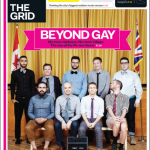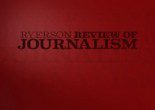On the Blink
A jaundiced glance at Eye Weekly
It was Toronto’s civic event of the season. Last fall’s mayoralty race saw the two front-runners crash head-on, flinging bits of cant and rhetoric, and the city’s three dailies hustling to cover the carnage. To no one’s surprise, The Globe and Mail and The Toronto Sun supported June Rowlands, the conservative candidate promising business booms ~nd smaller crime waves. The Toronto Star, in typical middling fashion, managed this advice: “Torontonians should vote against June Rowlands.” NOW, the city’s ll-year old news and entertainment. weekly, unequivocally pulled for underdog lefty Jack Layton, imploring its readers to choose between “a candidate who would make Toronto a meaner place to live, and one who would make our city a place to be proud of.”
But the most…uhhhhhhh…unique coverage came from eye WEEKLY, the new Star-financed paper designed to appropriate some of NOW’s lucrative market. The cartoon cover of eye’s fifth issue depicted the two aspiring mayors holding hands and strolling by city hall. The centre spread was devoted to a game called “Fun With Jack and June,” which asked the reader to “design your own tiny perfect mayor.” On the left were drawings of Rowlands in a one-piece bathing suit and Layton in briefs and suspenders. To the right were four costumes: a tutu, a police uniform, a regal robe and a dread-locked reggae outfit. Readers were then asked to colour the costumes, attach them to the candidates and send in their creations for a fabulous prize.
“Choosing between Jack and June,” read the probing, accompanying analysis, “is like choosing between retching and the runs.” It was telling copy, symbolic of a sensibility that managing editor William Burrill describes as “a bit irreverent and a bit twisted.” Unfortunately, eye pushes irreverence to the point of irrelevance, often reading more like a university engineering paper than a professional journal. For some reason-and this is the great mystery of eye WEEKLY-the corporate kingpins at the Star felt they could capture NOW’s faithful readership with an editorial approach that borders on the sophomoric and teeters toward the puerile.
The origins of eye can be traced back as far as 1985, when the Star introduced a weekly section called “What’s On.” Geared toward youthful readers, “What’s On” was a halfhearted response to the growing success of NOW and the TV generation’s declining interest in daily newspapers. The section was a limited success: it didn’t reach non-Star readers and it was a distant second to NOW in terms of comprehensiveness and street-level hipness. Yet none of this concerned the Star; the 1980s were great years for the paper, and record profits helped mute any worries concerning its underachieving entertainment section.
Then, in 1988, a paper named Metropolis challenged the young urban market monopolized by NOW. Two years later Metropolis was reduced to a Pizza Pizza giveaway after striking a distribution deal with Toronto’s largest pizza chain. While Metropolis probably deserved to expire-it suffered from spotty reporting as well as sauce-stained newsprint-it was probably put to rest by a sliding economy. The Star felt the squeeze as well: though 1989 represented the paper’s seventh consecutive year of record-breaking advertising sales, the gain over 1988 was a modest two percent. Meanwhile, by 1990 NOW’s advertising revenue clocked in at an estimated $6 million and, despite the socialist pretensions of NOW editors Michael Hollett and Alice Klein, their combined income approached $ 700,000 per annum.
With NOW’s enviable profit margin dangling before them like a platinum carrot, the Star renewed its interest in a freestanding entertainment paper. Consultants and focus groups convinced the Star that reaching.18- to 34-year-olds meant going to where young people spend time and money-in clubs, shops and restaurants. Prototype development for eye began in the fall of 1990; soon after, the project was called off, in part because of the worsening economy, in part to lull the competition into a false sense of security. In the summer of 1991 the idea was secretly revived, and the first issue of eye appeared in October of 1991.
If NOW can be characterized by its solemn, self-important tone, eye took a quantum pole vault in the opposite direction. From the silly “this is not the editorial page…” to the “eye was there” photo spread, the first issue was an exercise in frivolous excess, in adolescent silliness. Burrill set the tone. “What pisses you off?” he asked in his “Space for Rant” column. “Maybe it’s something big. Maybe it’s something tiny. We’re talkin’ waiters who pick their, noses… morons who loudly suck their teeth…racist pigs…dinks who take up two seats on a crowded streetcar… .” Dinks? Was this really Burrill’s conception of how young adults speak? Resonating in that monosyllabic slur was a microcosm of eye’s failings: a spectacular misreading of its audience.
“I think we’ve got a case of some older people aiming at a younger demographic and not pulling it off,” says Stan Sutter, a staff writer for Marketing, the bible of the advertising industry. “It feels tome like a bunch of guys in theirmid-30s andearly40s trying to be hip and 21.” Sutter’s approximation is not far off. Stephen Jarrett, eye’s editor, is in his early 40s, with kids; publisher Andrew Go is an 18-year Star veteran who also serves as director of advertising and new -product development.
“Toronto has one of the largest number of clubs, taverns and bars in North America,” Go says, justifying the need for eye. “NOW can have their share and we can have ours.” Convinced of market feasibility, Go again consulted his beloved focus groups; after eight weeks of testing he discovered that readers like a paper that is, among other things, “fun” to read. All of which would be fine were it not for eye’s self-admittedly twisted concept of fun. “I for one,” wrote a contributor to the editorial page, “believe that women have the right to achieve erect nipples without subjecting themselves to office air-conditioning.” The writer went on to describe his fantasy, a clinic where he and confederates kiss women’s breasts for a fee. It’s little wonder that Torontonians prefer the overly sanctimonious NOW; at least it doesn’t insult the reader. (Besides, NOW offers the best listings, probably the most important component of a news and entertainment weekly.)
It’s a shame, given that eye-in rare places-does show promise. Columns by media junkie Geoff Heinricks and Citytv environment reporter Bob Hunter are highlights, and music writer Chris O’Connor has a good handle on Toronto’s independent bands. More importantly, by the time eye returned from a two-week Christmas hiatus, it showed more willingness to cover serious topics. The cover of the third issue in January, for example, featured a close-up photo of a grey-haired man drawing on a cigarette. Inside was a companion two-page spread about street people and those helping them. The following week, part two of “The Homeless” offered a profile of Toronto’s largest hostel.
“They’ve obviously got some feedback that a completely juvenile publication is not what people are looking for,” says Michael Hollett, NOW’S far-from-diplomatic editor. “They’re trying to give it some weight. But I mean, doing the homeless? Will they do teenage pregnancy next? This is a magazine for people who are annoyed at the complexities of life. The people who put out eye are just darn sick and tired of how goddamn complex life is and all the thinking they’ve got to waste on it, so they try to reduce everything to its most base, belch-like essence.”
With its Village V Dice look and attitude NOW is firmly established as the alternative paper in town. The arrival of eye has, for the time being at least, had little effect on NOW’S podium-like status. Yet it’s worth noting that NOW had its own rocky start. The advertising market was soft in 1981, money for NOW’s operation was tight, and the writing was awful. I t took years for the paper to get to where it is today, and if Torstar is realistic, it will take years before eye will break even. But it could happen, particularly if eye capitalizes on recent business moves. It has a distribution deal with Cineplex Odeon and Famous Players that has one-fifth of eye’s 90,000 freebie copies going to movie theatre lobbies. As well, eye recently hired Nick Russo, NOW’s former circulation director.
Rather, eye’s biggest challenge will be improving its editorial content, a move synonymous with toning down its Three Stooges humour. But first-and it’s a big first-the higher-ups at eye must take a difficult step: realizing that improvements are both necessary and critical. Unfortunately, this realization could take some time to register. “Our first priority was to put out a good editorial product that fills the needs of our readers,” Andrew Go insists. “We feel we’ve achieved that as of today.”
Arthur Schwartzel was a Special Projects Editor for the Summer 1992 issue of the Ryerson Review of Journalism.













































